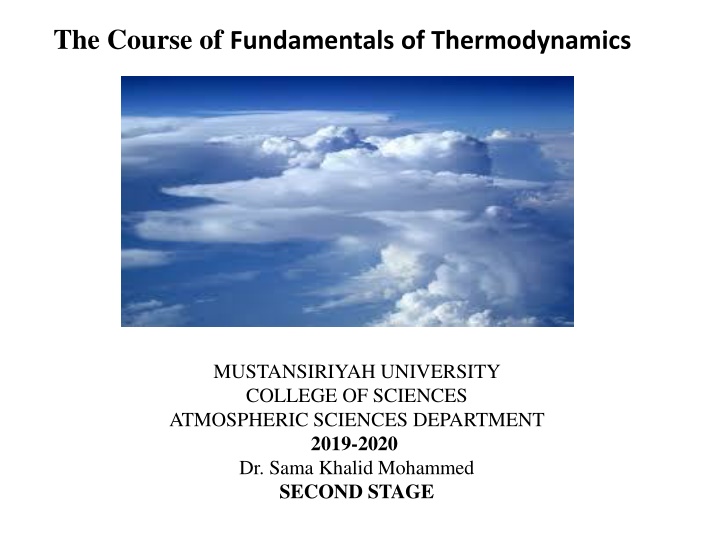
Understanding the Fundamentals of Thermodynamics: Enthalpy, Heat Capacities, and More
Explore the essential concepts of thermodynamics including enthalpy, heat capacities, specific heats, and the first law of thermodynamics for ideal gases. Understand the significance of using enthalpy, heat capacities, and specific heats in different processes.
Download Presentation

Please find below an Image/Link to download the presentation.
The content on the website is provided AS IS for your information and personal use only. It may not be sold, licensed, or shared on other websites without obtaining consent from the author. If you encounter any issues during the download, it is possible that the publisher has removed the file from their server.
You are allowed to download the files provided on this website for personal or commercial use, subject to the condition that they are used lawfully. All files are the property of their respective owners.
The content on the website is provided AS IS for your information and personal use only. It may not be sold, licensed, or shared on other websites without obtaining consent from the author.
E N D
Presentation Transcript
The Course of Fundamentals of Thermodynamics MUSTANSIRIYAH UNIVERSITY COLLEGE OF SCIENCES ATMOSPHERIC SCIENCES DEPARTMENT 2019-2020 Dr. Sama Khalid Mohammed SECOND STAGE
This lecture including the following items Enthalpy and why it is used. Heat capacities and specific heats Relation between cv and cp Specific heats for ideal gases The first law of thermodynamics for ideal gases Exercises
For Your Information If heat is added to a material at constant pressure so that the specific volume of the material increases from 1 to 2, the work done by a unit mass of the material is p( 2 - 1). as we know that: Then the finite quantity of heat q added to a unit mass of the material at constant pressure is given by : where u1 and u2 are, respectively, the initial and final internal energies for a unit mass of the material. Therefore, at constant pressure, where h is the enthalpy of a unit mass of the material,which is defined by Because u, p, and are functions of state, h is a function of state. Differentiating the last equation, we obtain
ENTHALPY It is one of the state variables, and is defined as H U + pV The differential of H is given as dH = dU + pdV + Vdp This makes it possible to write the first law of thermodynamics as: dH = dQ +Vdp (1)
WHY USING ENTHALPY? The reason enthalpy is convenient to use is that for constant pressure processes, dp = 0 and so dH = dQ. o Since many thermodynamic processes in the atmosphere occur at constant pressure, change in enthalpy and heat are equivalent and are used interchangeably in such processes. o In an isobaric (constant pressure) process, dW = dU dH , which states that the work is the difference in the changes of internal energy and enthalpy. From the first form of the first law, dU = dQ pdV, we see that at constant volume, dU = dQ. o For constant volume processes, heat and change in internal energy are interchangeable. For constant pressure processes, heat and enthalpy change are equivalent. For constant volume processes, heat and internal energy change are equivalent.
HEAT CAPACITIES AND SPECIFIC HEATS Heat capacity is the amount of heat Q needed to raise the temperature of a substance T by one degree. Heat capacity is defined in terms of either a constant volume process or a constant pressure process (At constant pressure, some of the heat supplied goes into doing work of expansion and less is available with the system ) ?? ??? (2) From the two forms of the first law (dH = dQ), and (dU = dQ), we can show that: ?? ?? ? ?? ?? ???(3) ??= ??= ?? ?? ?? ?? ?? = = ? ? ? so that the definitions for heat capacity can also be written as ?? ?? ?? ???(4) ?? (5) ?? ?
HEAT CAPACITIES AND SPECIFIC HEATS The units of heat capacity are J K 1. Heat capacity is an extensive property (depends on amount of matter ), tts intensive counterpart is called specific heat, and is defined as ?? ?? ? ???(7) ?? ?? ?? ???(6) ?= ?= The units of specific heat are J K 1 kg 1. Heat capacities and specific heats are not constant, but are functions of T and p. If a substance has higher heat capacity, then more heat has to be added to raise its temperature.
RELATION BETWEEN Cv and Cp To see the relation between Cv and Cp we start with the: ?? ??? ?? ??? ?? ?? = (8) From the definition of enthalpy, H =U + pV , we take the partial derivative with respect to T at constant pressure to get: ?? ???= ?? ?? ?? ???(9) +? ? Substituting (9) into (8) we get ?? ???+ ? ?? ?? ?? ???(10) ?? ?? = ? The differential of U is: ?? ???dT + ?? ??? ?? ?? =
RELATION BETWEEN Cv and Cp Dividing by dT gives: ?? ??= ?? ???+ ?? ??? ?? ?? and assuming constant pressure we get: ?? ???= ?? ?? ?? ??? ?? ??? + ? Or ?? ???= ?? ?? ?? ??? ?? ???(11) + ? ?? ???+ ? ?? ?? ?? ???(10) Substituting this into (10) ?? ?? = ? ?? ???+ ? ?? ??? (12) ?? ?? = gives
RELATION BETWEEN Cv AND Cp In terms of specific heats this is: ?? ? ?+ ? ? ??? ?? ?? = (13) (??/??)?or (??/? )T is called the internal pressure, and is due to forces between the molecules of the substance. Riddles For gases, Cp > Cv, why?
SPECIFIC HEATS FOR IDEAL GASES Recall that the specific heat at constant volume and the specific heat at constant pressure was defined as: ?? ?? ? ?? ?? ?? ? ? Since the internal energy and enthalpy of an ideal gas depend only on temperature, then for an ideal gas we don t have to write the specific heats as partial derivatives, but can instead use full derivatives ?? ?? ?? ? ?? ?? From the expressions for the internal energy of ideal gases, ?? 5 ?? 3 we get that 2R for monatomic gas ; 2R for diatomic gas
SPECIFIC HEATS FOR IDEAL GASES The expression relating the specific heats at constant pressure and at constant volume is also greatly simplified for an ideal gas. The general expression [Eqn. (13)] becomes, for an ideal gas, Cp-Cv=R (14) which tells us that: ?? 7 ?? 5 2R for diatomic gas 2R for monatomic gas ; 99% of the atmosphere is composed of diatomic molecules (N2 and O2), and has a specific gas constant of 287.1 J-kg 1-K 1. This leads to values of Cv and Cp of 718 J-kg 1-K 1 and 1005 J-kg 1-K 1. These values are extremely close to the measured values for the atmosphere.
THE FIRST LAW OF THERMODYNAMICS FOR IDEAL GASES The specific heats for ideal gasses are ??=?? ?? ??=? ?? From these we can write ??=Cv dT dh=Cp dT Using these expressions in the first law of thermodynamics results in the following two forms for the first law: Cv dT=dq-pd ; Cp dT=dq+ dp (First Law of Thermodynamics for Ideal Gas) We are often most interested in how the thermodynamic variables change with time. By dividing the first law by dt we get: ?? ??=?? ??-p? ?? ??=?? ??+ ?? Cv (First Law of Thermodynamics for Ideal Gas) ?? ; Cp ??
THE FIRST LAW OF THERMODYNAMICS FOR IDEAL GASES In meteorology, the most common form of the first law used the last equation. Cv ?? ??=?? ??-p? ?? ??=?? ??+ ?? ?? ; Cp ?? There are many different symbols used for the heating term. Some common ways that you will see the first law written in other textbooks are ?? ?? w =?? ?? ??+ ?? ?? ?? ?? Cp ?? Bluestein(1992) CV ?? = J Holton(1992) Cp ?? = H Houze(1993) The first law is often referred to as the thermodynamic equation or thermodynamic energy equation.



















